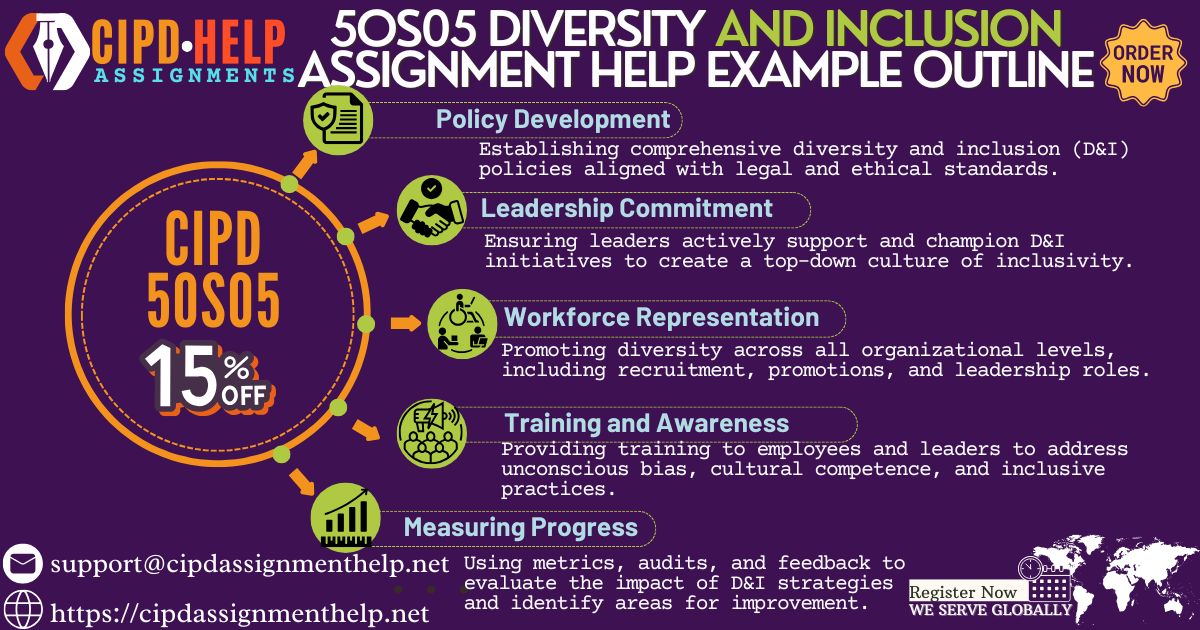5OS05 Diversity and Inclusion Assignment Help Example Outline
Assignment Task 1: Understand the importance of embracing diversity and inclusion in organisations.
Assess The Value Of Diversity And Inclusion In Organizations For Employees, Customers, And Wider Stakeholders.
- Give a brief description of diversity and inclusion in organisations
- Diversity
- Representation in the organisation – including race, religion, sexual orientation, gender, ethnicity
- Inclusion
- Valuing, respecting, supporting and incorporating the contributions of various groups of people in the organisation
- Diversity
- The importance of embracing diversity and inclusion in organisations
- For employees
- Increase employee retention
- Improve employee engagement
- Develop employee skills
- For customers
- Improved customer loyalty
- Better customer service
- Develop stronger relationships with customers
- For wider stakeholders – for example; government bodies, local communities, non-governmental organisations, shareholders and business partners
- Improved reputation for the employer (the shareholders)
- Stronger relationship with the local communities
- Meet government laws on diversity and inclusion in organisations
- For employees
- What are the implications for people practice professionals in the workplace?
Explain The Key Elements Of The Legal Framework Surrounding Diversity And Inclusion.
- Give a brief description for a legal framework
- What is the legal framework surrounding diversity and inclusion in organisations?
- Anti-discrimination laws
- Workplace harassment
- Policies and procedures supporting an inclusive workplace
- The key elements of the legal framework surrounding diversity and inclusion
- Advocate for under-represented groups
- The recruitment process
- Addressing unconscious bias
- Have an inclusive workplace culture
- Training
- What are the implications for people practice professionals in organisations?
Identify The Barriers To Achieving Diversity And Inclusion In Organisations.
- Barriers to achieving diversity and inclusion in organisations
- Lack of diversity in leadership
- Resistance to change
- Communication challenges
- How do these barriers impact the implementation of diversity and inclusion initiatives in organisations?
- How can these barriers be addressed in an organisation?
- What are the implications for people practice professionals in organisations?
Assignment Activity 2: Be able to ensure diversity and inclusion is reflected and promoted in the organisation.
Conduct An Organizational Review To Improve Diversity And Inclusion In An Organizational Context.
- Give a brief description of an organisational context – for example; the internal and external factors impacting an organisation and its objectives.
- Organisational Review
- Goal: To improve diversity and inclusion in an organisational context
- Issues of diversity and inclusion
- Multigenerational workforce
- Communication issues
- Discrimination in the workplace
- Gender diversity
- Measures to improve on these issues in an organisational context
- Embrace effects of globalisation and outsourcing to include in the workforce people of different generations including immigrants, outsourcing, and the aging population.
- Address language barriers and conflicting preferences by promoting the use of a common language, and accepting different communication styles.
- Promote equality in the workplace to address discrimination due to disability, race, sex, marital status and country of origin among other factors.
- Have a balanced gender workforce that includes both men and women in the organisation.
Conduct an equality impact assessment (EqIA) to ensure that there are no disproportionate impacts on protected individuals or groups.
- What is an equality impact assessment (EqIA)?
- Who are the protected individuals or groups in the workplace? For example
- The aging population
- People of colour
- Women
- Immigrants
- Whistle-blowers
- What are the disproportionate impacts on protected individuals or groups in an organisation?
- Indirect discriminations or unintended discriminations in the workplace – for example;
- During recruitment – the organisation uses job postings and recruitment strategies that inadvertently exclude certain groups.
- Selection processes – the HR department uses pre-employment tests or criteria that disproportionately affect specific groups like the disabled and women.
- Promotion and advancement – the organisation has policies and practices that limit opportunities for certain employees to advance.
- Indirect discriminations or unintended discriminations in the workplace – for example;
- An Equality Impact Assessment
- Goal: To ensure that there are no disproportionate impacts on protected.
- Issues to be addressed
- indirect discrimination in the workplace
- Action plan: What are the measures to ensure that there are no disproportionate impacts on protected individuals or groups in organisations?
- Invite proposals for effective solutions
- Involve and consult all stakeholders on the need for addressing unintentional or indirect discrimination in the organisation
- The people affected by the action
- Monitoring and review of the actual impact of the action/solution
- Funding
- Evaluation
Develop approaches to strengthen diversity and inclusion within organizational policies and practices.
- Give a brief description of organisational policies and practices
- What does strengthening diversity and inclusion entail?
- Approaches to strengthen diversity and inclusion in organisational policies and practices
- Diversity training
- Build inclusion in the workplace
- Implement and encourage diverse leadership
- Promote effective communication
- How can these approaches be incorporated in organisational policies and practices to strengthen diversity and inclusion?
- What are the implications for people practice professionals in organisations?
Learning Outcome 3: Be able to embed best practice approaches to diversity and inclusion.
Evaluate the role managers and leaders play in creating an organizational culture that fully embraces diversity and inclusion.
- Give a brief description of organisational culture
- Explain an organisational culture that fully embraces diversity and inclusion
- What is the role of managers and leaders in creating an organisational culture that fully embraces diversity and inclusion?
- Create a welcoming environment
- Set the tone
- Develop an inclusive leadership team
- Communicate commitment to diversity and inclusion in the organisation
- What are the implications for people practice professionals in organisations?
Recommend approaches that organizations can take to celebrate difference and engender a culture of diversity and inclusion among workers and other stakeholders.
- Celebrating difference and engender a culture of diversity and inclusion among workers and other stakeholders.
- What does it entail in an organisation?
- Approaches that organisations can take to celebrate difference and engender a culture of diversity and inclusion among workers and other stakeholders.
- Create a diverse hiring and recruitment process
- Acknowledge cultural day celebrations
- Build and recognise employee resource groups
- Foster interactional diversity
Develop approaches to measure and monitor the impact of a diverse and inclusive organizational culture.
- The impact of a diverse and inclusive organisational culture
- Open potential for talent pool and attract the best
- Win over diverse customers
- Achieve enhanced performance through greater innovation and creativity
- Builds a culture of trust
- Approaches to measure and monitor impact of a diverse and inclusive organisational culture
- Use focus groups to obtain employee feedback
- Assess turnover and retention rates
- Conducting regular audits and assessments on gaps and areas of improvement
- Monitoring employee resource groups – to establish the level of inclusivity and supportive the organisation is.
- What are the implications of these approaches to people practice professionals?





